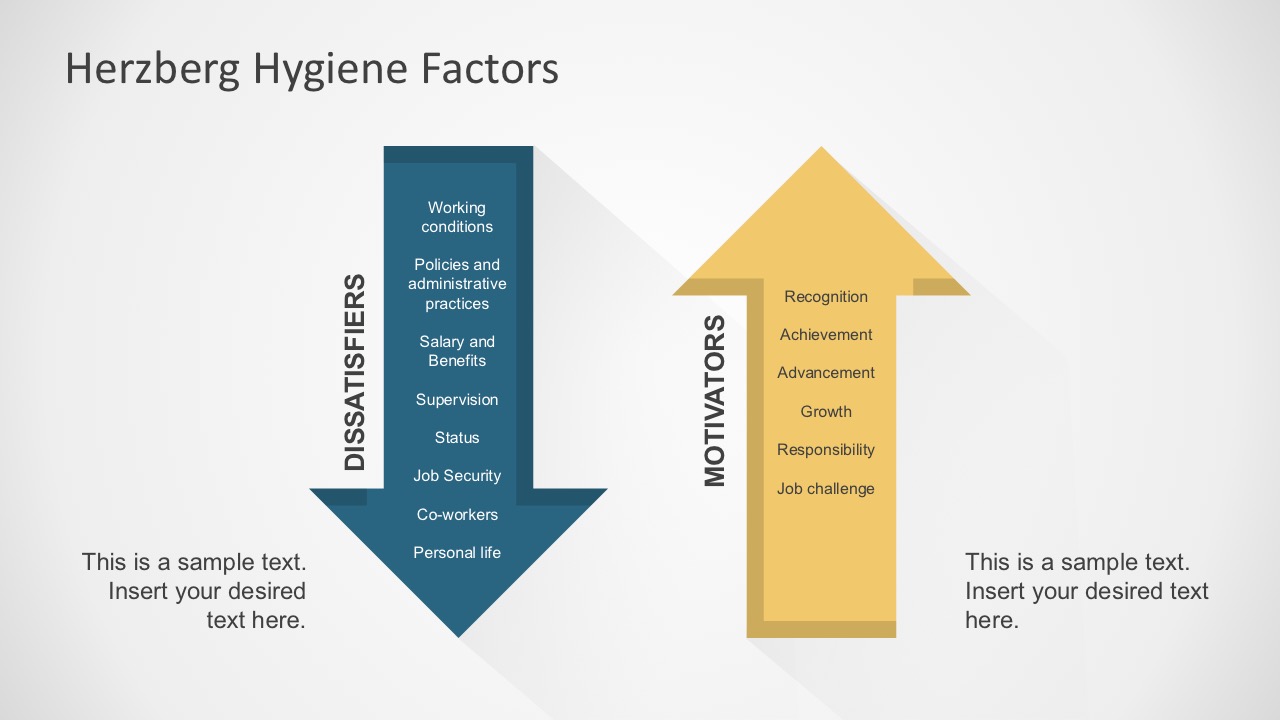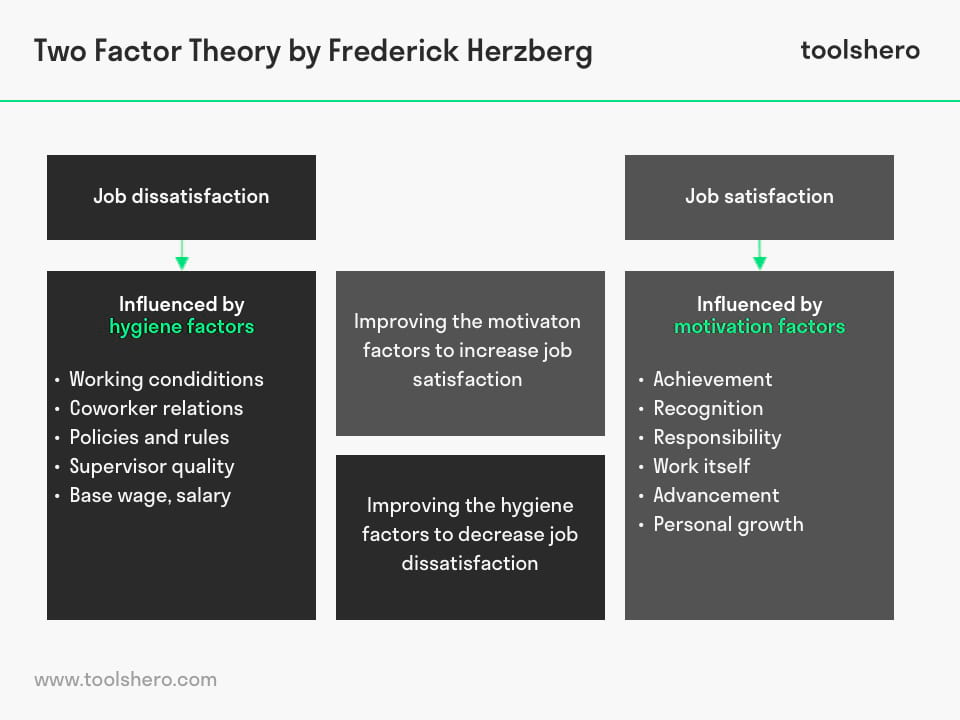I. Introduction to Herzberg’s Two-Factor Theory
Definition and Overview of the Theory
Herzberg’s Two-Factor Theory, also known as the Motivation-Hygiene Theory, is a psychological theory that focuses on employee motivation and job satisfaction in the workplace. According to this theory, there are two sets of factors that influence an individual’s satisfaction and motivation at work: hygiene factors and motivators. Hygiene factors are extrinsic factors that, when absent, can lead to dissatisfaction, but when present, do not necessarily lead to satisfaction. Motivators, on the other hand, are intrinsic factors that, when present, can lead to satisfaction and motivation.
The theory suggests that improving hygiene factors can help prevent dissatisfaction, while increasing motivators can enhance job satisfaction and motivation. Hygiene factors are essential for employees to feel comfortable and content in their work environment, while motivators drive individuals to excel and feel fulfilled in their roles.
Historical Background of the Theory
Herzberg’s Two-Factor Theory was proposed by Frederick Herzberg, an American psychologist, in 1959. Herzberg conducted a series of studies in the 1950s and 1960s, interviewing employees in various industries about their job satisfaction and dissatisfaction. Through his research, he identified two distinct sets of factors that influenced employee motivation and satisfaction.
Herzberg’s theory challenged the prevailing belief at the time that job satisfaction and dissatisfaction were on a single continuum. Instead, he argued that there were separate factors that contributed to these two states. This groundbreaking theory provided insights into the complexities of human motivation and laid the foundation for future research in the field of organizational behavior and management.
To learn more about Herzberg’s Two-Factor Theory and its implications for employee motivation, you can visit this Wikipedia page.

II. The Motivation-Hygiene Factors
One of the key concepts in Herzberg’s Two-Factor Theory is the distinction between motivators and hygiene factors. These factors are essential in understanding employee motivation and satisfaction in the workplace.
Explanation of the two factors: motivators and hygiene factors
Motivators: Motivators are factors that directly contribute to an employee’s satisfaction and motivation in their work. These factors are typically intrinsic and related to the nature of the work itself. They include:
- Achievement: Employees who are given challenging tasks and have the opportunity to make significant contributions to the organization are more likely to be motivated.
- Recognition: Employees who feel valued and appreciated for their work are more likely to feel motivated to perform well.
- Responsibility: Giving employees autonomy and the ability to make decisions can increase their motivation and engagement.
- Growth and Development: Providing opportunities for learning and advancement can motivate employees to improve their performance.
Hygiene factors: Hygiene factors, on the other hand, are factors that do not directly contribute to an employee’s motivation, but their absence can lead to dissatisfaction and unhappiness in the workplace. These factors are typically extrinsic and related to the work environment. They include:
- Salary and Benefits: Employees expect to be fairly compensated for their work and receive benefits that meet their needs.
- Job Security: Feeling secure in their job can contribute to an employee’s overall satisfaction and motivation.
- Work-Life Balance: Employees who are able to maintain a healthy balance between work and personal life are more likely to feel motivated.
- Working Conditions: A comfortable and safe working environment can contribute to employee satisfaction.
Examples of motivators in the workplace
- Giving employees challenging and meaningful work that allows them to use their skills and abilities.
- Providing opportunities for growth and advancement, such as training programs or promotions.
- Recognizing and rewarding employees for their achievements and contributions.
- Encouraging teamwork and collaboration to foster a sense of belonging and achievement.
Examples of hygiene factors in the workplace
- Ensuring employees receive fair compensation and benefits that meet their needs.
- Providing a safe and comfortable work environment.
- Offering job security and stability.
- Promoting work-life balance by implementing flexible work arrangements.
Understanding and addressing both motivators and hygiene factors in the workplace is essential for boosting employee motivation and satisfaction. By focusing on creating a motivating work environment and addressing employees’ basic needs, organizations can create a positive and engaging workplace culture.
 Source: www.careershodh.com
Source: www.careershodh.comIII. Motivators: Factors that Drive Employee Satisfaction
To truly understand Herzberg’s Two-Factor Theory and its impact on employee motivation, it is essential to explore the motivators that drive employee satisfaction. These factors are the aspects of work that provide employees with a sense of fulfillment and achievement. Here is an in-depth discussion of each motivator factor and how to implement them in the workplace:
In-depth discussion of each motivator factor:
- Achievement: Employees are motivated by the opportunity to accomplish challenging goals and experience a sense of personal achievement. This can be fostered by providing employees with meaningful and challenging assignments, recognizing their accomplishments, and offering opportunities for growth and development.
- Recognition: Employees crave appreciation and acknowledgment for their contributions. Recognizing and rewarding good performance can boost motivation and morale. This can be achieved through formal recognition programs, regular feedback and praise, and public recognition of achievements.
- Growth and Advancement: Employees are motivated when they see opportunities for career growth and advancement within the organization. Providing clear career paths, offering training and development programs, and promoting from within can foster a sense of motivation and loyalty among employees.
- Responsibility: Giving employees autonomy and ownership over their work can be a powerful motivator. Allowing employees to make decisions, delegate tasks, and take on leadership roles can enhance their sense of responsibility and increase their motivation.
How to implement motivators in the workplace:
- Conduct regular performance evaluations and provide constructive feedback to employees to help them grow and improve.
- Recognize and reward outstanding performance through bonuses, promotions, or other forms of recognition.
- Encourage and support employees’ professional development by offering training programs, workshops, or opportunities for higher education.
- Foster a positive work environment where employees feel comfortable expressing their ideas and opinions.
- Implement a mentorship program where experienced employees can guide and support their colleagues.
- Delegate meaningful tasks and projects to employees to give them a sense of ownership and responsibility.
Case studies or examples of successful implementation:
- Google’s “20% Time”: Google famously allows its employees to spend 20% of their time working on personal projects that interest them. This motivates employees by giving them the opportunity to pursue their passions and contribute to the organization’s innovation.
- Zappos’ Core Value Recognition Program: Zappos offers a program where employees can recognize and reward their colleagues for demonstrating the company’s core values. This motivates employees by reinforcing the importance of these values and providing a sense of appreciation and belonging.
- Patagonia’s Environmental Activism Program: Patagonia encourages employee engagement in environmental activism by providing paid time off for volunteering and organizing environmental initiatives. This motivates employees by aligning their work with their personal values and fostering a sense of purpose.
Implementing these motivators in the workplace can lead to increased employee satisfaction, engagement, and productivity. By understanding and leveraging Herzberg’s Two-Factor Theory, organizations can create a work environment that nurtures and motivates their employees.
 Source: slidemodel.com
Source: slidemodel.comIV. Hygiene Factors: Factors that Prevent Employee Dissatisfaction
In-depth discussion of each hygiene factor
According to Herzberg’s Two-Factor Theory, hygiene factors are the factors that can prevent employee dissatisfaction but do not necessarily lead to employee satisfaction or motivation. These factors are essential for creating an environment where employees feel comfortable and secure. Here are some in-depth discussions of each hygiene factor:
1. Salary and Compensation: Fair and competitive compensation is crucial for employee satisfaction. Employees need to feel that they are adequately rewarded for their work and that their compensation is in line with industry standards.
2. Company Policies and Procedures: Clear and transparent policies and procedures help create a sense of fairness and equity within the organization. Employees need to know what is expected of them and how they will be treated if they adhere to company policies.
3. Physical Work Environment: Employees should have a clean, safe, and comfortable work environment. Factors such as lighting, temperature, noise levels, and ergonomic equipment can significantly impact employees’ well-being and job satisfaction.
4. Job Security: Employees need a sense of stability and job security to feel motivated and satisfied in their roles. Organizations should strive to provide employees with a sense of job stability, fair employment contracts, and reasonable notice periods for termination.
5. Work-Life Balance: Balancing work and personal life is crucial for employee well-being. Organizations should promote work-life balance through flexible work arrangements, vacation policies, and support systems for employees facing personal challenges.
How to address hygiene factors in the workplace
To address hygiene factors and prevent employee dissatisfaction, organizations can take several steps:
• Conduct a thorough review: Evaluate the current status of each hygiene factor within the organization. Identify areas that need improvement and prioritize actions based on their impact on employee satisfaction.
• Regularly communicate with employees: Keep employees informed about company policies, changes, and any other relevant information. Encourage open communication channels to address any concerns or questions employees may have.
• Provide competitive compensation and benefits: Regularly review and adjust salary and benefits packages to ensure they are in line with industry standards and meet employees’ expectations.
• Maintain a safe and comfortable work environment: Regularly assess and address any physical or environmental factors that may impact employee well-being. Provide necessary training and resources to ensure employees can perform their tasks safely.
• Foster work-life balance: Encourage a healthy work-life balance by promoting policies and practices that support employees’ personal lives. Offer flexibility in work schedules, promote wellness programs, and educate employees about the importance of self-care.
Case studies or examples of successful resolution
Several organizations have successfully addressed hygiene factors and improved employee satisfaction. For example:
• Google: Google provides its employees with competitive salaries and benefits, a comfortable work environment, and a range of perks and amenities that contribute to high employee satisfaction.
• Salesforce: Salesforce puts a strong emphasis on work-life balance, offering flexible work arrangements and generous vacation policies. The company also provides various wellness programs to support employee well-being.
• Patagonia: Patagonia is known for its commitment to sustainability and work-life balance. The company promotes flexible work schedules, encourages employees to engage in outdoor activities, and provides generous parental leave policies.
By addressing hygiene factors and creating a positive work environment, organizations can prevent employee dissatisfaction and create a foundation for higher levels of motivation and satisfaction among their workforce.
V. Applying Herzberg’s Two-Factor Theory in Employee Motivation Strategies
Implementing Herzberg’s Two-Factor Theory can greatly enhance employee motivation and satisfaction in the workplace. Here are some key points to consider when applying this theory to your motivation strategies:
Importance of understanding individual needs and preferences
• Individuality: Recognize that each employee has unique needs and preferences when it comes to motivation. Take the time to understand what motivates each individual and tailor your strategies accordingly.
• Feedback: Regularly communicate with your employees to understand their satisfaction levels and what factors are influencing their motivation. This open dialogue can help you identify areas for improvement and implement targeted strategies.
Strategies for incorporating motivators and addressing hygiene factors
• Motivators: Focus on providing opportunities for personal growth, recognition, and achievement. Encourage employees to set ambitious goals and provide them with the necessary resources and support to succeed.
• Hygiene Factors: Pay attention to the factors that can cause dissatisfaction, such as salary, working conditions, and company policies. Ensure that these basic needs are met and address any issues promptly.
Tips and best practices for implementing the theory in the workplace
• Recognition and Rewards: Implement a recognition and rewards program to acknowledge and appreciate the contributions of your employees. This can be in the form of verbal praise, bonuses, promotions, or other incentives.
• Professional Development Opportunities: Provide opportunities for employees to learn and grow professionally. Offer training programs, workshops, and mentorship opportunities to help them develop new skills and advance in their careers.
• Flexibility and Work-Life Balance: Consider implementing flexible work arrangements or remote work options to accommodate the diverse needs of your employees. This can help improve their work-life balance and overall job satisfaction.
Remember, Motivation is a complex and ongoing process. By understanding and implementing Herzberg’s Two-Factor Theory, you can create a work environment that fosters motivation, engagement, and ultimately, the success of your organization.
VI. Benefits of Implementing Herzberg’s Two-Factor Theory
Positive impact on employee satisfaction and engagement
Implementing Herzberg’s Two-Factor Theory can have a significant positive impact on employee satisfaction and engagement in the workplace. By addressing both hygiene factors and motivators, organizations can create an environment that fosters happiness and job satisfaction. Some benefits include:
- Reduced turnover: When employees feel satisfied and engaged, they are more likely to stay with the organization, reducing turnover rates and retaining valuable talent.
- Improved morale: By recognizing and addressing hygiene factors such as fair compensation, working conditions, and job security, employees feel more valued and motivated, leading to increased morale.
- Enhanced job satisfaction: Addressing motivators such as recognition, achievement, and growth opportunities creates a fulfilling work environment, leading to higher job satisfaction levels among employees.
- Higher employee engagement: When employees feel motivated and satisfied, they are more likely to be engaged in their work, resulting in increased productivity, creativity, and discretionary effort.
Increased productivity and performance
Implementing Herzberg’s Two-Factor Theory can also lead to increased productivity and performance within an organization. Some of the benefits include:
- Greater commitment: When employees feel satisfied and motivated, they are more committed to their work and the organization’s goals, putting in their best effort to achieve positive results.
- Improved quality of work: Motivated employees are more likely to produce high-quality work, as they are driven by a sense of achievement and personal growth.
- Efficient teamwork: Motivated team members are more likely to collaborate effectively, communicate openly, and contribute positively to team dynamics, leading to improved teamwork and collective performance.
Case studies or examples of organizations that have successfully applied the theory
Several organizations have successfully implemented Herzberg’s Two-Factor Theory to improve employee motivation and satisfaction. One example is Google, which offers various motivators such as opportunities for personal growth and development, recognition, and a positive work culture. Another example is Netflix, which focuses on providing fair compensation, flexibility, and a challenging work environment to motivate its employees. These organizations have demonstrated the effectiveness of addressing both hygiene factors and motivators in creating a fulfilling and motivating work environment.
Implementing Herzberg’s Two-Factor Theory can bring numerous benefits to organizations, including improved employee satisfaction and engagement, increased productivity and performance, and reduced turnover. By understanding and addressing the factors that influence employee motivation, organizations can create a positive and motivating work environment that drives success.
 Source: www.toolshero.com
Source: www.toolshero.comVIII. Conclusion
Recap of Herzberg’s Two-Factor Theory
In conclusion, Herzberg’s Two-Factor Theory is a valuable framework for understanding and improving employee motivation in the workplace. The theory suggests that there are two sets of factors that influence job satisfaction and dissatisfaction – hygiene factors and motivators. Hygiene factors are related to the work environment and include factors such as salary, working conditions, and company policies. Motivators, on the other hand, are intrinsic to the job itself and include factors such as recognition, achievement, and personal growth.
According to Herzberg, hygiene factors are essential for preventing job dissatisfaction, but they do not necessarily lead to long-term satisfaction and motivation. Motivators, on the other hand, have the potential to drive employee engagement and job satisfaction.
Key takeaways and actionable steps for boosting employee motivation
Based on Herzberg’s Two-Factor Theory, here are some key takeaways and actionable steps for boosting employee motivation:
- Focus on both hygiene factors and motivators: It is crucial to address hygiene factors to prevent job dissatisfaction. Ensure that employees have fair compensation, comfortable working conditions, and clear company policies. Additionally, focus on providing motivators such as opportunities for growth and development, recognition of achievements, and meaningful and challenging work.
- Foster a positive work environment: Create a positive and supportive work environment where employees feel valued and appreciated. Encourage open communication, collaboration, and teamwork. Provide regular feedback and recognition to employees for their contributions.
- Empower employees: Give employees autonomy and decision-making authority in their roles. Provide opportunities for learning and development to enhance their skills and knowledge. Involve employees in decision-making processes and encourage them to take ownership of their work.
Final thoughts on the significance of the theory in contemporary workplaces.
Herzberg’s Two-Factor Theory remains relevant and significant in contemporary workplaces. It provides a valuable understanding of the factors that influence employee motivation and satisfaction. By addressing both hygiene factors and motivators, organizations can create a positive work environment that fosters employee engagement and productivity. Understanding and applying Herzberg’s theory can help organizations create a motivated workforce and achieve long-term success.
For more information on Herzberg’s Two-Factor Theory, you can visit the Wikipedia page on the subject.




